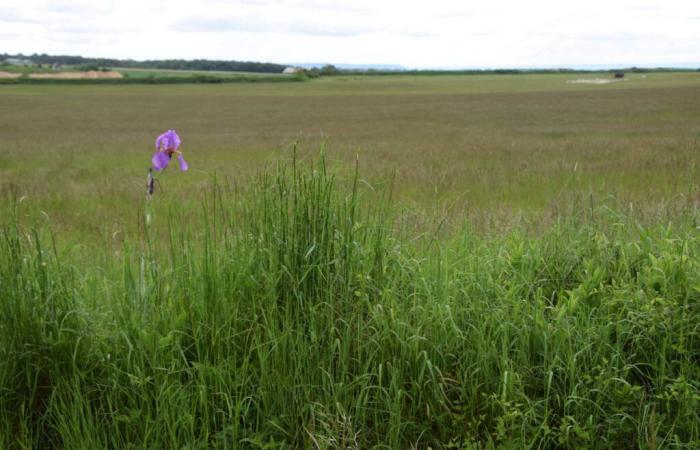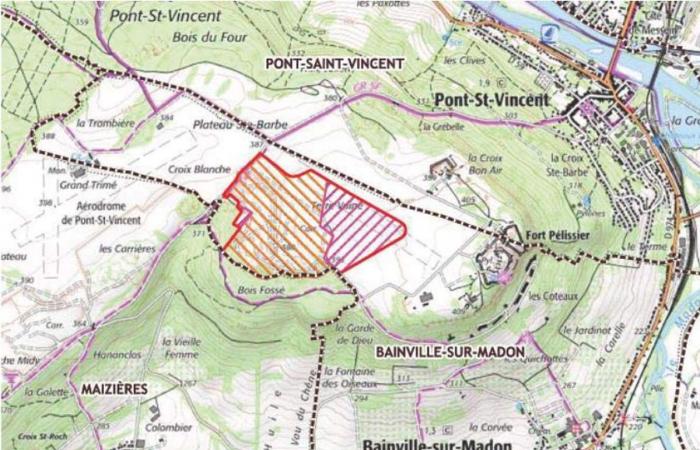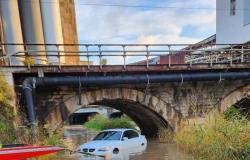A decisive general assembly will be held on November 5 in Pont-Saint-Vincent, approximately 15 km from Nancy, to decide on collective actions to be taken against the proposed extension of the Plateau Sainte-Barbe quarry.
Starting from Fort Pélissier, a stony path runs along a ledge of greenery. On the right, below, Pont-Saint-Vincent borders the canalized Moselle. A few houses escape onto the hillside and bask in the sun. In front, in the distance, the flying club from which large white birds take off when the weather permits. The experienced hiker will prefer to cross a small hill, on his left, by slipping under a stunted tree. This is the thousand-year-old moorland of the Sainte-Barbe plateau in Bainville-sur-Madon, in Meurthe-et-Moselle, about fifteen kilometers from Nancy. Walking here is prohibited. Sacrilege, even, because of the ecological interest of this 180 ha limestone lawn classified Sensitive natural space and even Natural area of ecological, fauna and flora interest (ZNIEFF). To which is added the APPB (Prefectural decree to protect the biotope of the Sainte-Barbe plateau).
Here, time has stood still to offer rare and protected species the natural environment they need to flourish. There are several species of orchids in abundance, such as the Burnt Orchis. But also remarkable entomological populations: grasshoppers, crickets, locusts; butterflies like the Flambé or the Grand damier; reptiles, such as the coronella, the wall lizard; or the yellow-bellied ringing toad. A universe as fascinating as it is fragile.
An open-air quarry
As you cross the moor, the sounds of construction machinery disturb the tranquility of the place. This is an operating quarry. In the past, the stones were extracted here which were used in the construction of the Saint-Epvre church in Nancy. For around twenty years, the company Carrières & Matériaux Nord Est (CMNE), owned by the Société des Carrières de l'Est group (a subsidiary of the Colas-Est group), has produced and sold aggregates to construction professionals and individuals. natural, limestone materials of different grain sizes for construction (roads and buildings).
Tens of thousands of tons of stone are extracted each year from this open-air quarry. Every day of the week, an uninterrupted ballet of large trucks goes up and down the small winding road which leads from the RD 974 to the Sainte-Barbe plateau and the Bainville-sur-Madon quarry. Sometimes a mine blast shakes the surrounding homes.
Extension request contested
The authorization to operate the quarry expires at the end of 2024. The operator has therefore logically requested an authorization to renew but also to extend the quarry for a period of 30 years, including 28 years of exploitation (9,920,000 tonnes over 28 years, or 350,000 tonnes per year) and two years to complete the restoration and redevelopment of the site.
The extension covers an area of 14 ha of limestone lawn. The elected officials of the Moselle-et-Madon community modified the PLU (land use plan) accordingly. They take into account the economic interest of such a company in their territory. And the royalties that go with it for the municipality of Bainville alone. However, many residents of the surrounding villages are opposed to the requested authorizations. And they make it known.
Associations, demonstrations, petitions…
Grouped together within several associations, these dissatisfied local residents are asking the Meurthe-et-Moselle prefecture to refuse authorizations for continued exploitation and especially for extension of the quarry. THE Citizen collective to protect the Sainte-Barbe plateau (CCPPSB) qu anime Joëlle Herrault, [composé de l’association Chaligny en Transition et Résister et Agir en Moselle et Madon (R§Agir)] lead the fight. Their arguments? The necessary safeguarding of limestone lawns, the preservation of protected species, the risks of collapse of the underground galleries supplying drinking water to the commune of Pont-Saint-Vincent, the noise pollution from dump trucks, the risks of mine blasts for homes , etc.
They also fear the backfilling of the existing quarry with waste from construction which “will transform the plateau into a huge waste dump with a possible risk of groundwater pollution” as René Denille, co-president of R§Agir, points out.
The Collective organized meetings, demonstrations in front of the headquarters of the community of communes of Neuves-Maisons, notably on June 7, 2024. And even a petition which, to date, has collected more than 3,400 signatures.
The “favorable” public inquiry
The public inquiry lasted 53 days. It received 1116 visitors and countless sightings. It ended on June 7, 2024 with a “favorable opinion” from the investigating commissioner, Jean-Michel Hablainville.
The latter, however, expresses two reservations:
- Carry out seismographic surveys as soon as possible in the property of the plaintiffs in the Pont-Saint-Vincent heights sector (rue Albert Munier and neighboring areas) in order to measure vibrations during mine blasts. Take measurements for a minimum of two months and communicate the results to DREAL;
- Ask the prefect of Meurthe-et-Moselle for the creation of a CSS (Site Monitoring Commission), according to article L125-2-1 of the Environmental Code, as soon as possible exploitation authorization is granted, including integrating local associations and the municipalities of Bainville-sur-Madon and Pont-Saint-Vincent, with at least one annual meeting.
The operator's arguments
In this document, the operator CMNE specifies that it complies with all regulatory texts in force, in particular Installations classified for environmental protection (ICPE). It is seeking environmental authorization for:
- Operation over 28 years with extraction of 350,000 tonnes/year on average (max 500,000 tonnes/year)
- Mine blasts controlled by seismographs according to the standards of Ineris (National Institute of the Industrial Environment and Risks).
- The progressive backfilling of the site using: o 2 million m³ of site materials, o 4.5 million m³ of external inert waste
- Limited recycling (1-2% or 2,500 to 5,000 tonnes) of materials received
- A redevelopment of limestone lawn with paths and educational panels
To limit the impact, the operator proposes:
- A limited visual impact from the village and the road,
- Installation of protective embankments around the site
- Strict control of inert materials received
- The temporary landscape impact on the plateau, compensated by the final renaturation
The CMNE specifies: “The project is entirely in line with the notion of sustainable development because it intends to meet the needs of the local population while preserving the environment for future generations. The project therefore aims to continue supplying the local market by saving alluvial materials. This substitution of alluvial materials by limestone was encouraged by the Departmental Quarry Scheme and this orientation is continued in the Regional Quarry Scheme currently being finalized. »
“An attack on the environment”
Opponents are not convinced. “What guarantee do we have that the construction waste that will be brought in for backfilling will be truly inert and that there will be no toxic inputs,” asks the Collective? Who will control? “.
Others add: “A quarry is in itself an attack on the environment, we don't want that. »
They drew up a catalog of arguments in 20 points (see below). The strongest argument is that further extraction of aggregates is not justified. “The reference to the Departmental Careers Plan is completely obsolete” assert the opponents. »
After several letters to the prefect of Meurthe-et-Moselle, the dissatisfied local residents decided to meet on Tuesday, November 5 at 6 p.m., in Pont-Saint-Vincent. This involves “reactivating the Association for the Defense of the Environment of the Sainte-Barbe Plateau (ADEP) which is currently dormant,” explains René Denille. ADEP, chaired by Thierry Barateau, will be able to collect funds and carry out various actions against the project.
A sublime view of the plain
They intend to protect ''their'' limestone lawn of great biological wealth. The small stony path of the plateau leads away from the quarry and leads to Fort Pélissier, a remarkable area of leisure and relaxation. From the belvedere, 420 m above the Moselle and Madon valleys, the plain offers a mosaic of shapes and colors with tidy houses along the road, fields with irregular geographical contours, a dark forest at the foot of the hill of Zion. And, in the distance, over there, on the horizon, the blue line of the Vosges.
To be continued…
What local residents want and don't want







